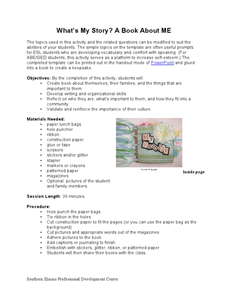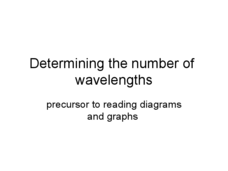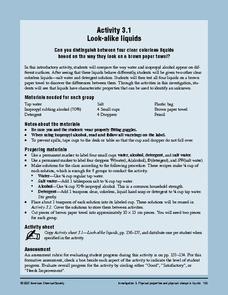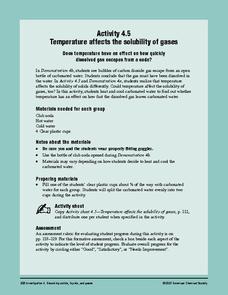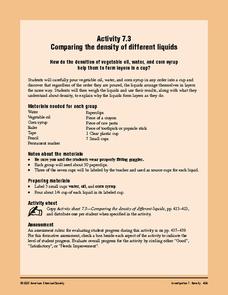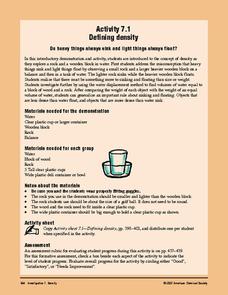Curated OER
Derivatives of the Trig Functions
Twelfth graders analyze the derivatives and use trig functions to practice using the derivative. In this calculus lesson, 12th graders derive the 6 trigonometric functions using the derivative and their properties. They complete practice...
Curated OER
My Worst Best Sleepover Party
Students read the book The Best Worst Sleepover Party and discuss their feelings about bullying. In this bullying lesson plan, students discuss anxiety bullying, and what qualities a friend should have. Students design classroom...
Curated OER
Graphing Situations without a Table
Students graph a line without making a table of vales. In this algebra lesson plan, students are given a verbal scenario and asked to write a linear functions representing the scenario and graph it on a number line without making a...
Read Works
Textual Analysis Lesson: Boys vs. Girls: It's Not Just in Your Head
The main characters in Bridge to Terabithia do no quite live up to their gender expectations. Explore this idea with a reading passage called "Boys vs. Girls: It's Not Just in Your Head." Included in the plan are detailed...
Curated OER
Research Paper
An outline for a research paper assignment lists the expectations, grading rubric, and due dates for an extended research writing project.
Curated OER
Inspirational Mapping for the Corps of Discovery
Third graders use a computer software entitled, Inspiration, in order to create a map or web of what Lewis and Clark should have packed for their journey west. They are given the expectations of the teacher and a scoring guide is...
Curated OER
Jeopardy
Power, matter, and energy sources are the subjects of this Jeopardy game. It provides a review of general science topics and expects students to know the basic details of machines, matter types, and some energy types. This...
Curated OER
What's My Story? A Book About Me
Have your class create keepsake books about themselves. This activity is a presented as a basic idea with minimal justifications or classroom applications. However, with a little effort, this could become a full activity. Add a rubric,...
Curated OER
Determining the Number of Wavelengths
After displaying three diagrams showing 1, 1 1/2, and 2 wavelengths, the slide show presents more diagrams and expects pupils to determine the number of wavelengths in each. No labels or explanations are provided, so this would be useful...
Curated OER
Global Warming
Four slides attempt to explain global warming. The first mentions that Earth's climate has experienced major changes throughout history, but that scientists believe humans are now changing it. The second explains why this is...
Curated OER
Answering an Essay Style Question
Writing an essay can seem like a daunting task, but it can be a lot easier when learners are given an outline of expectations. This resource provides a step-by-step explanation of how to answer an essay question. However, the...
Curated OER
Homeostasis and the Human Body
Don't expect much from this presentation. It contains five slides in addition to the title. The first describes homeostasis, the second states that it operates at all levels and lists the biological hierarchy, the third gives three...
Curated OER
Express Whole Numbers as Fractions
Apply fractions in the real world using these 10 word problems, each of which has a space for scholars to work out the equation. The problems give whole numbers for scholars to work with, and there aren't any mixed number answers. Pupils...
Sharp School
The Jungle Project: Creating a Magazine
To conclude a study of Upton Sinclair's The Jungle, groups create a multi-media magazine in which they investigate one aspect of the foods industry. The packet details the requirements for the project, and includes rubrics for...
Haiku Deck
Haiku Deck - Beautiful Presentations and Slideshows with Charts and Graphs
Create beautiful and simple presentations, sales pitches, lessons, and visual stories that utilize Getty Images, high quality photos licensed under Creative Commons, as well as your own prints. What you create will demand people’s...
Model Me Kids
Model Me Going Places 2
Social stories are wonderful teaching tools specifically designed for learners with Asperger's, autism, PDD-NOS, non-verbal learning disabilities, or other developmental disabilities. They are used to model appropriate social behaviors...
American Chemical Society
Condensation
It's time to break the ice! If you are doing all of the lessons in the unit, children have already seen that increasing heat increases the rate of evaporation, but is the opposite true? Does decreasing temperature cause more condensation...
American Chemical Society
Dissolving a Substance in Different Liquids
Second of six lessons in a unit on dissolving, this one focuses on how sugar behaves in different liquids. Learners stir it into water, alcohol, and oil and make observations. This lesson can stand alone, but is best used as part of the...
American Chemical Society
Defining Dissolving
Physical science investigators mix sugar and food coloring into different cups of water and cooking oil to compare how the solid and liquid behave in each. As the introduction to this unit on dissolving, it is relevant.
American Chemical Society
Look-Alike Liquids
Here is the first of four experiments to differentiate among unknown liquids by their behaviors and properties. Pupils observe how different liquids respond to being placed on plastic and paper, and they take notes about their...
American Chemical Society
Temperature Affects the Solubility of Gases
Dare your class to drive dissolved carbon dioxide out of carbonated liquid at different temperatures to discover if there is a difference in rate. To make this experiment more sound, have explorers use equally measured amounts of soda...
American Chemical Society
Comparing the Density of Different Liquids
Learners will like making a liquid layer cake to investigate the relative densities of various liquids: water, oil, and corn syrup. They will also introduce a few solid materials to find out how their densities compare. Standing alone,...
American Chemical Society
Using Chemical Change to Identify an Unknown
If you have taught the first lesson in this mini unit, learners already know that cabbage juice and vinegar cause chemical changes in some materials. Now, they get a chance to use them to compare the liquids' reactions to five known and...
American Chemical Society
Defining Density
Three simple activities kick off a unit investigation of density. Your physical scientists make observations on the volume and mass of wood, water, and rocks, and make comparisons. Though this is written for grades three through eight,...
Other popular searches
- Great Expectations
- Great Expectations Quiz
- Dickens Great Expectations
- Great Expectations Unit
- Employer Expectations
- Great Expectations Test
- Class Expectations
- Great Expectations Review
- Classroom Expectations
- Family Expectations
- Great Expectations Unit Test
- Expectations of Adolescents









